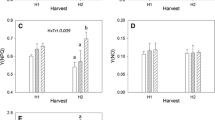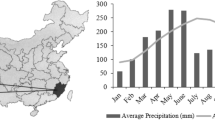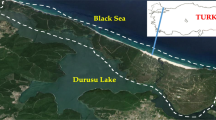Abstract
The weathering of soil minerals in forest ecosystems increases nutrient availability for the trees. The rate of such weathering and its relative contribution to forest tree nutrition, is a major issue when evaluating present and potential forest stand productivity and sustainability. The current paper examines the weathering rate of plagioclase with and without Douglas-fir or Scots pine seedlings, in a laboratory experiment at pH 3–4 and 25 °C. All nutrients, with the exception of Ca, were supplied in sufficient amounts in a nutrient solution. The objective of the experiment was to evaluate the potential of trees to mobilise Ca from the mineral plagioclase that contained 12% of Ca. Amounts of nutrients supplied in the nutrient solution, amounts accumulated in the living tissue of the seedlings and amounts leached from the experimental vessels, were measured. A weathering balance, accounting for leached + accumulated − supplied amounts, was established. Bio-induced weathering, defined as the weathering increase in the presence of trees, relative to the weathering rate without trees (geochemical weathering; control vessels), under the present experimental conditions, explained on average, 40% of total weathering (biological + geochemical). These conditions appeared more beneficial to Scots pine (higher relative growth rate, higher Ca incorporation) than to Douglas-fir.
Similar content being viewed by others
References
Alexandre A, Meunier J D, Colin F and Koud J M 1997 Plant impact on the biogeochemical cycle of silicon and related weathering processes. Geochim. Cosm. Acta 61, 677–685.
April R and Keller D 1990 Mineralogy of the rhizosphere in forest soils of the eastern United States. Mineralogical studies of the rhizosphere. Biogeochemistry 9, 1–18.
Arocena J M and Glowa K R 2000 Mineral weathering in ectomycorrhizosphere of subalpine fir (Abies lasiocarpa (Hook.) Nutt.) as revealed by soil solution composition. For. Ecol. Manage. 132, 61–70.
Augusto L, Turpault M-P and Ranger J 2000 Impact of forest tree species on feldspar weathering rates. Geoderma 96, 215–237.
Augusto L, Ranger J, Turpault M-P and Bonnaud P 2001 Experimental in situ transformation of vermiculites to study the weathering impact of tree species on the soil. Eur. J. Soil Sci. 52, 81–92.
Barker W W and Banfield J F 1998 Zones of chemical and physical interaction between microbial communities and minerals: A model. Geomicrobiology 15, 223–244.
Barker W W, Welch S A and Banfield J F 1997 Biogeochemical weathering of silicate minerals. In Geomicrobiology: Interactions between microbes and minerals. Eds. J F Banfield and Nealson K H. Reviews in Mineralogy (Mineralogical Society of America) Vol. 35, pp. 391–428.
Blum A E and Stillings L L 1995 Feldspar dissolution kinetics. In Chemical weathering rates of silicate minerals. Eds. A F White and S L Brantley. Reviews in Mineralogy (Mineral Society of America) Vol. 31, pp. 291–351.
Bonneau M 1995 Fertilisation des forêts dans les pays tempérés. Théorie, bases du diagnostic, conseils pratiques, réalisations expérimentales. ENGREF, Nancy. 367 pp.
Bormann B T, Wang D, Bormann F H, Benoit G, April R and Snyder M C 1998 Rapid, plant-induced weathering in an aggrading experimental ecosystem. Biogeochemistry 43, 129–155.
Brantley S L 1992 Kinetics of dissolution and precipitation: Experimental and field results. In Water-rock interactions. Eds. Y K Khanaka and A S Maest. pp. 3–6. AA Balkema, Rotterdam.
van Breemen N, Finlay R, Lundström U, Jongmans A G, Giesler R and Olsson M 2000 Mycorrhizal weathering: A true case of mineral plant nutrition? Biogeochemistry 49, 53–67.
Courchesne F and Gobran G R 1997 Mineralogical variations of bulk and rhizosphere soils from a Norway spruce stand. Soil Sci. Soc. Am. J. 61, 1245–1249.
Darrah P R 1993 The rhizosphere and plant nutrition: A quantitative approach. Plant Soil 155/156, 1–20.
Drever J I 1994 The effect of land plants on the weathering rate of silicate minerals. Geochim. Cosmochim. Acta 58, 2325–2332.
Drever J I and Stillings L L 1997 The role of organic acids in mineral weathering. Colloïds and Surface A: Physicochem. Engin. Aspects 120, 167–181.
Eltrop L and Marschner H 1996 Growth and mineral nutrition of non-mycorrhizal and mycorrhizal Norway spruce (Picea abies) seedlings grown in semi-hydroponic sand culture. I. Growth and mineral nutrient uptake in plants supplied with different forms of nitrogen. New Phytol. 133, 469–478.
Ezzaïm A, Turpault M-P and Ranger J 1999 Quantification of weathering processes in an acid brown soil developed from tuff (Beaujolais, France). Part II. Soil formation. Geoderma 87, 155–177.
George E, Seith B, Schaeffer C and Marschner H 1997 Responses of Picea, Pinus and Pseudotsuga roots to heterogeneous nutrient distribution in soil. Tree Physiol. 17, 39–45.
Gijsman A J 1990 Rhizosphere pH along different root zones of Douglas-fir (Pseudotsuga menziesii), as affected by source of nitrogen. Plant Soil 124, 161–167.
Gobran G R and Clegg S 1996 A conceptual model for nutrient availability in the mineral soil-root system. Can. J. For. Res. 76, 125–131.
Hinsinger P 1998 How do plant roots acquire mineral nutrients? Chemical processes involved in the rhizosphere. Adv. Agronomy 64, 225–265.
Hinsinger P, Fernandez Barros O N, Benedetti M F, Noack Y and Callot G 2001 Plant-induced weathering of a basaltic rock: experimental evidence. Geochim. Cosmochim. Acta 65, 137–152.
Hinsinger P, Jaillard B and Dufey J E 1992 Rapid weathering of a trioctahedral mica by the roots of ryegrass. Soil Sci. Soc. Am. J. 56, 977–982.
Hodson M E 1999 Micropore surface area variation with grain size in unweathered alkali feldspars: Implications for surface roughness and dissolution studies. Geochim. Cosmochim. Acta 62, 3429–3435.
Holdren G R Jr and Berner R A 1979 Mechanisms of feldspar weathering. I Experimental studies. Geochim. Cosmochim. Acta 43, 1161–1171.
Jongmans A G, van Breemen N, Lundström U S, van Hees P A W, Finlay R D, Srinivasan M, Unestam T, Giesler R, Melerud P-A and Olsson M 1997 Rock-eating fungi. Nature 389, 682–683.
Leyval C and Berthelin J 1991 Weathering of a mica by roots and rhizospheric microorganisms of pine. Soil Sci. Soc. Am. J. 55, 1009–1016.
Lundström U and Öhman L O 1990 Dissolution of feldspars in the presence of natural, organic solutes. J. Soil Sci. 41, 359–369.
Marques R and Ranger J 1997 Nutrient dynamics in a chronosequence of Douglas-fir (Pseudotsuga menziesii (Mirb.) Franco) stands on the Beaujolais Mounts (France). 1: Qualitative approach. For. Ecol. Manage. 91, 255–277.
Nye P H 1981 Changes of pH across the rhizosphere induced by roots. Plant Soil 61, 7–26.
Paris F, Bonnaud P, Ranger J and Lapeyrie F 1995 In vitro weathering of phlogopite by ectomycorrhizal fungi. I. Effect of K+ and Mg2+ deficiency on phylosillicates evolution. Plant Soil 177, 191–201.
Ranger J, Allié S, Gelhaye D, Pollier B, Turpault M-P and Granier A 2002 Nutrient budgets for a rotation of a Douglas-fir plantation in the Beaujolais (France) based on a chronosequence study. For. Ecol. Manage. 171, 3–16.
van der Salm C, Verstraten J M and Tiktak A 1996 The influence of percolation rate on the weathering rates of silicates in an E horizon of an Umbric Albaquafl. Geoderma 73, 83–106.
Sposito G 1989 The environmental chemistry of aluminum. CRC Press, Boca Raton.
Stillings L L and Brantley S L 1995 Feldspar dissolution at 25 °C and pH3: Reaction stochiometry and the effect of cations. Geochim. Cosmochim. Acta 59, 1483–1496.
Stillings L L, Drever J I, Brantley S L, Sun Y and Oxburgh R 1996 Rates of feldspar dissolution at pH 3–7 with 0–8 mMoxalic acid. Chem. Geol. 132, 79–89.
Swoboda-Colberg N G and Drever J I 1993 Mineral dissolution rates in plot-scale field and laboratory experiments. Chem. Geol. 105, 51–69.
Velbel M A 1990 Influence of temperature and mineral surface of feldspar weathering rates in natural and artificial systems: A first approximation. Water Resour. Res. 26, 3049–3053.
Wallander H and Wickman T 1998 Biotite and microcline as potassium sources in ectomycorrhizal and non-mycorrhizal Pinus sylvestris seedlings. Mycorrhiza 9, 25–32.
Wallander H, Wickman T and Jacks G 1997 Apatite as a P source in mycorrhizal and non-mycorrhizal Pinus sylvestris seedlings. Plant Soil 196, 123–131.
Welch S A and Ullman W J 1993 The effect of organic acids on plagioclase dissolution rate and stoichiometry. Geochim. Cosmochim. Acta 57, 2725–2736.
White A F, Blum A E, Bullen T D, Vivit D V, Schulz M and Fitzpatrick J 1999 The effect of temperature on experimental and natural chemical weathering rates of granitoïd rocks. Geochim. Cosmochim. Acta 63, 3277–3291.
Author information
Authors and Affiliations
Corresponding author
Rights and permissions
About this article
Cite this article
Bakker, M.R., George, E., Turpault, M.P. et al. Impact of Douglas-fir and Scots pine seedlings on plagioclase weathering under acidic conditions. Plant Soil 266, 247–259 (2005). https://doi.org/10.1007/s11104-005-1153-7
Received:
Accepted:
Issue Date:
DOI: https://doi.org/10.1007/s11104-005-1153-7




